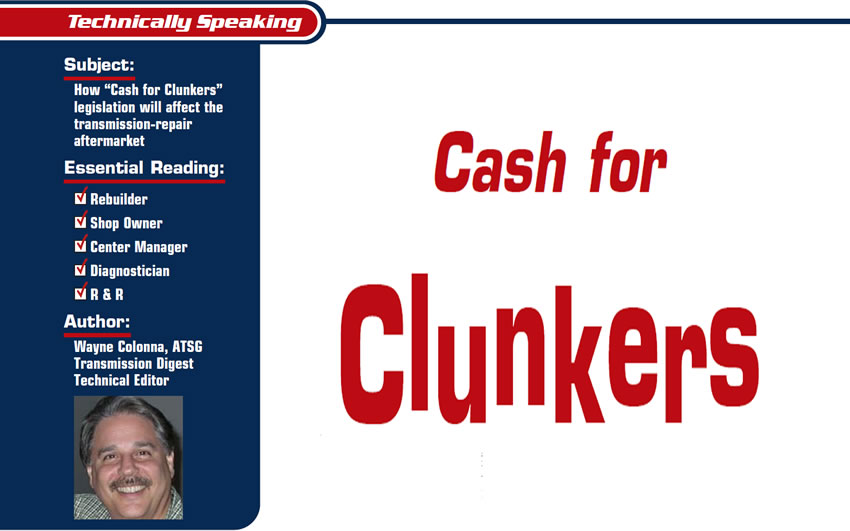
Technically Speaking
- Subject: How “Cash for Clunkers” legislation will affect the transmission-repair aftermarket
- Essential Reading: Shop Owner, Center Manager, Rebuilder, Diagnostician, R&R
- Author: Wayne Colonna, ATSG, Transmission Digest Technical Editor
The U.S. House of Representatives and Senate have passed a $4-billion bill (#2751) under the Consumer Assistance to Recycle and Save Act called “Cash for Clunkers.” The Democrats were the most in favor, causing the bill to pass with a margin of 298-119 in the House and 60-36 in the Senate.
President Obama quickly signed the bill into law. However, he needed $4 billion to fund the bill. So to get the program up and running, he found $1 billion, and Cash for Clunkers became a part of a war-spending bill and is now officially called CARS (Car Allowance Rebate System). It will be overseen by the National Highway Traffic Safety Administration.
How the bill works is that people who trade in a clunker will receive a voucher worth $3,500 or $4,500 toward the purchase of a new “more fuel-efficient” car or truck. The new vehicle must have a minimum fuel economy of 22 mpg to qualify for the voucher. If the new car’s fuel efficiency is improved by at least 4 mpg compared with their previous car, the consumer will receive a $3,500 voucher. If the new car’s fuel efficiency is improved by at least 10 mpg, the consumer will receive a $4,500 voucher.
The vouchers apply to vehicles purchased or leased between July 1 and Nov. 1. With only $1 billion to start the program, finding the additional $3 billion provides a reason to revisit this bill later in the year.
The supposed purpose of the bill is to increase fuel savings nationwide by providing consumers an incentive to trade in their old “high-polluting, gas guzzling” automobiles and replace them with new fuel-efficient and less-polluting automobiles. Although this all sounds good up front, the real driving force of the bill is to push new-car sales. So if the dealers who registered to participate in the “cash for guzzlers” program convince the government that the Cash for Clunkers did well for them and they need it to continue, this could encourage Congress to find that $3 billion dollars and extend the program into 2010.

Personally, I believe this program is designed to help not the poor or the middle class but the upper middle class and the rich. After all, after a $4,500 down payment and a few extra dollars if you have it (and a job), you still have several years if not more in car payments.
My hat is off to the Specialty Equipment Market Association (SEMA), which was able to get a 25-year provision inserted into the law to prevent any car older than the 1984 model year from being crushed. But this still endangers cars newer than 1984, as some of them could be future collectibles. But if they are forced by law to be crushed, who would know whether the 1995 Oldsmobile Aurora or a 1997 Plymouth Prowler would ever be a collectible?
For the limited time and eligibility of those cars that will be bought with these vouchers, SEMA and other aftermarket associations persuaded lawmakers to permit the drivetrain to be recycled if the transmission, driveshaft and/or differential are sold as separate parts. At this time the law prohibits recycling of the engine, which is to be crushed with the rest of the vehicle. SEMA is hard at work to turn this around as well. To read SEMA’s messages to President Obama and congressional leaders, visit http://www.semasan.com/main/main.aspx?id=60855.
All in all, at this time this program will have a limited effect in the aftermarket repair industry. The danger is if it becomes a permanent program.
The idea to eliminate “high-polluting, gas guzzling” automobiles and replace them with newer fuel-efficient and less-polluting automobiles under the “environmentally friendly” banner is all eyewash and talking out of both sides of the mouth. The amount of greenhouse gases (carbon dioxide) produced and emitted into the atmosphere in making new automobiles to replace the old makes for a weak environmental argument. In comparison, it is much more environmentally friendly to repair and upgrade existing vehicles, and this is what we, the aftermarket repair industry, should support.
It would be good to write to your U.S. senator or representative about this issue, or to get involved with associations that are actively representing the aftermarket repair industry on the Hill, such as SEMA, APRA, AAIA, ATRA, MEMA and others. For years ATSG members have been eligible for discounted APRA membership fees, receiving benefits from both organizations, and this is one of the reasons why such arrangements were made. The larger we are the more of a voice we have – especially in a government bound and determined to give away all our hard-earned money. So let’s help them keep us in business so we can pay for it all!














